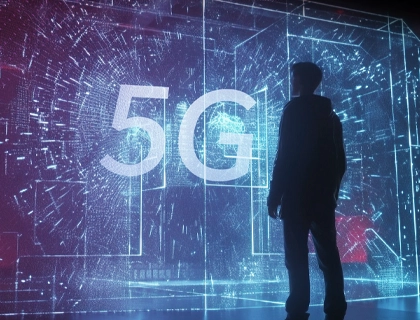
As businesses struggle to balance their sustainability initiatives against the need to handle exponentially growing data traffic volumes, SDN will play a key role in reducing the carbon burden of computer networks.
6 Mins
18th April 2022
Article
Sustainability, Connectivity
Many organisations use vast amounts of energy to operate and cool their network infrastructure, producing a significant amount of carbon waste in the process.
An International Energy Agency report¹ indicated that globally, data transmission networks consumed 260-360 TWh in 2022, which made up about 1‑1.5% of global electricity use. And this is growing exponentially as emerging digital technologies such as blockchain, machine learning, 5G and virtual reality raise the demand for data services.
To contain the burgeoning carbon footprint of digital networks, one thing that must be done is to rein in the proliferation of hardware by improving utilisation rates.
Businesses tend to build excess capacity into their ICT infrastructure – including networks and data centres - to cater to anticipated demand growth and ensure optimal performance at any moment. This infrastructure build-out raises overall network energy use because networks generally have high fixed energy costs.
Another course of action to reduce the network’s carbon footprint would be to channel data traffic through greener infrastructures, for example, those that utilise more energy-efficient cooling systems. However, this would be difficult to do with a traditional network where the control plane and the data plane are tightly coupled, and adapting to any change will require every network component to be reconfigured. In addition, the routing of traffic to travel through more energy-efficient pathways will require a new level of flexibility in the way networks operate.
Software-defined networks (SDN) are key to addressing some of these issues.
While SDN was not specifically designed to tackle energy conservation and carbon reduction goals, there is potential in using the technology to optimise network infrastructure, reduce switching power consumption and facilitate the transition to sustainable networks.
SDN is a relatively new networking paradigm that eliminates the tight coupling between the control and forwarding functions. In traditional network design, both functions resided in the switch. With SDN, the control plane is separated from the data plane. It sits in a central controller, whilst the data plane resides at the switches.
A vital advantage of this approach is that it paves the way for enterprises to have a global view of the network and allows the infrastructure to be controlled and monitored centrally. It also makes the network programmable by allowing changes to be done on the controller and propagated to the entire network.
There are software-based approaches within the SDN itself, such as the traffic-aware and end system-aware models for enhancing energy efficiency².
With a traffic-aware controller, energy consumption can be reduced by turning off some forwarding switches during low traffic load or putting CPUs or ports to sleep mode. For example, a study by Assefa and Özkasap³ reported that when the traffic load is low (e.g., during night times), this can save up to 50% of the total energy consumption.
With the end system-aware approach, the goal is to minimise the number of active physical machines by migrating the virtual machines into a fewer number of physical machines and turning off underutilised servers.
An overlay of SDN-enabled switches and links is formed to connect virtual machines. This allows for server consolidation - placing as many virtual machines as possible to fewer physical machines to minimise the number of active physical machines. The overlay also enables network optimisation by minimising the transport cost of migrating virtual machines from one physical machine to another.
From a carbon reduction perspective, an immediate benefit of this is that it allows network administrators to consolidate networking workloads on fewer devices, maximising the hardware utilisation rate. Switches that are not used can then be turned off or put on standby mode, reducing power consumption and cooling overheads.
SDNs also eliminate the need for businesses to over-provision infrastructure to meet peak capacity requirements and “just-in-case” scenarios. Instead, the technology enables the network to be scaled rapidly by tapping on all the switches in a network to handle traffic flows. For example, traffic loads and ports can be shared, and link aggregation tasks can be spread over the available switching fabric.
The programmability of SDN also means that network behaviours can be modified dynamically to meet the requirements of different use cases. For example, the switching fabric can be configured to handle more transaction-oriented business flows during the day and large media streaming applications during the night. This eliminates the need to provision, power and cool multiple network setups, paving the way for significant reductions in the carbon footprint.
SDN also contributes to the carbon reduction cause by being a significant enabler for adopting “green” network technologies. The technology makes it easy for network managers to distribute usage – and the power consumption needs that go with it - to those most energy-efficient parts or have the “greenest” infrastructure.
With the software-defined paradigm, network switch configurations can be transferred from one set of devices to another almost instantaneously and without interruption, compared to a traditional networking approach where it could take hours to effect the changes.
Communication paths can be dynamically selected based on their current carbon footprint. This makes it feasible and economically viable for whole networks to be moved dynamically to facilities that provide the “greenest” solution.
As businesses struggle to balance the sustainability imperative against the need to handle exponentially growing traffic volumes, SDN will play a key role alongside other green technologies in reducing the carbon burden of computer networks.
The programmability of the infrastructure, with its software-based approaches to tackling energy efficiency, will help in carbon reduction by improving hardware utilisation and consolidation and lowering barriers to the adoption of greener solutions.
Ready to reduce your carbon footprint? Speak to us to find out more.
1IEA, Data Centres and Data Transmission Networks, 2023
2,3Journal of Network and Computer Applications, A Survey of Energy Efficiency in SDN: Software-based Methods and Optimisation Models, 2019.

Sustainability, Manufacturing and logistics, Smart cities

Healthcare, 5G, Network slicing, Smart cities

5G, Network slicing

Sustainability

5G, Healthcare, Network slicing, Smart cities

Healthcare, 5G, Retail, Finance, Manufacturing and logistics, Enterprise mobile protect
Get the latest digest on business and technology trends straight to your inbox.